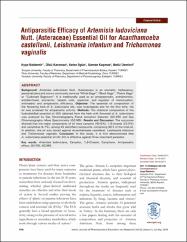| dc.contributor.author | Baldemir, Ayşe | |
| dc.contributor.author | Karaman, Ülkü | |
| dc.contributor.author | İllgün, Selen | |
| dc.contributor.author | Kaçmaz, Gamze | |
| dc.contributor.author | Demirci, Betül | |
| dc.date.accessioned | 2019-10-19T14:15:14Z | |
| dc.date.available | 2019-10-19T14:15:14Z | |
| dc.date.issued | 2018 | |
| dc.identifier.issn | 0019-5464 | |
| dc.identifier.uri | https://dx.doi.org/10.5530/ijper.52.3.48 | |
| dc.identifier.uri | https://hdl.handle.net/11421/12703 | |
| dc.description | WOS: 000441465700010 | en_US |
| dc.description.abstract | Background: Artemisia ludoviciana Nutt. (Asteraceae) is an aromatic, herbaceous, perennial plant and known commonly name as "White Sage", "Black Sage", "Prairie Sage" or "Cudweed Sagewort". It is traditionally used as an antispasmodic, anthelminthic, antidiarrhoeal, stomachic, hepatic colic, appetizer, and regulator of menstruation, antimalaric and antiparasitic efficiancy. Objective: The essential oil composition of the flowering herb of A. ludoviciana (AL) was investigated and for the first time, the oil was screened for antiparasitic activity. Methods: The chemical composition of the hydrodistilled essential oil (E0) obtained from the herb with flowered of A. ludoviciana was analyzed by Gas Chromatography-Flame Ionization Detector (GC-FID) and Gas Chromatography-Mass Spectrometry (GC-MS). Results and Discussion: The outcomes showed that the major components of oil were camphor (40.6%), 1,8-cineole (25.5%) and camphene (4.7%), among 45 identified compounds, comprising 98.5 of the total oil. In addition, the oil was tested against Acanthamoeba castellanii, Leishmania infantum and Trichomonas vagina/is. Conclusion: In this study, it is first demonstrated that A. ludoviciana essential oil (AL-EO) is effective against three important parasites. | en_US |
| dc.description.sponsorship | Erciyes University Scientific Research Foundation (Kayseri, Turkey) [THD-2016-6590] | en_US |
| dc.description.sponsorship | This study was supported by the Erciyes University Scientific Research Foundation (Kayseri, Turkey) [Project number: THD-2016-6590]. We would like to thank for Leishmania infantum strains to Prof. Dr. Yusuf OZBEL and Prof. Dr. Seray TOZ (Ege University), and for A. castellani strains to thank Prof. Dr. Serpil DEGERLI (Cumhuriyet University) and also Biologist Necati OZPINAR (Cumhuriyet University) for Trichomonas vaginalis strains. Authors would like to thank Zeytinburnu Medicinal Plant Garden (Istanbul, Turkey) for supply A. ludoviciana culture form. | en_US |
| dc.language.iso | eng | en_US |
| dc.publisher | Assoc Pharmaceutical Teachers India | en_US |
| dc.relation.isversionof | 10.5530/ijper.52.3.48 | en_US |
| dc.rights | info:eu-repo/semantics/openAccess | en_US |
| dc.subject | Artemisia Ludoviciana | en_US |
| dc.subject | Camphor | en_US |
| dc.subject | 1,8-Cineole | en_US |
| dc.subject | Camphene | en_US |
| dc.subject | Antiparasitic Effect | en_US |
| dc.subject | Gc-Fid | en_US |
| dc.subject | Gc/Ms | en_US |
| dc.title | Antiparasitic Efficacy of Artemisia ludoviciana Nutt. (Asteraceae) Essential Oil for Acanthamoeba castellanii, Leishmania infantum and Trichomonas vaginalis | en_US |
| dc.type | article | en_US |
| dc.relation.journal | Indian Journal of Pharmaceutical Education and Research | en_US |
| dc.contributor.department | Anadolu Üniversitesi, Eczacılık Fakültesi, Farmakognozi Anabilim Dalı | en_US |
| dc.identifier.volume | 52 | en_US |
| dc.identifier.issue | 3 | en_US |
| dc.identifier.startpage | 416 | en_US |
| dc.identifier.endpage | 425 | en_US |
| dc.relation.publicationcategory | Makale - Uluslararası Hakemli Dergi - Kurum Öğretim Elemanı | en_US |
| dc.contributor.institutionauthor | Demirci, Betül | |


















